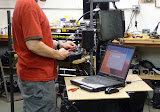Finishing up a couple of connections on the wiring harness now that the ecu is plugged in.
Testing continuity. Making sure that all the wires go where they are supposed to and that none are crossed.
My goal for the night was to get the wiring harness installed all the power and grounds hooked up properly (there are several of each), and get the ECU talking to the laptop so that I can look over the parameters. So far as all that’s concerned, and in the works of the great decider GWB “Mission accomplished”. And just as hollow as those words turned out to be so to was my goal or at least the feeling I know have in my stomach. I got the ECU connected and the software is talking and I was able to download the maps and all the base config settings. After looking over them for a few minutes the only words that come to my mouth are “HOLY SHIT!” It’s late and I’m tired so this is probably simpler than it looks but the number of variables is a bit staggering. I’m at the base of what at first glance appears to be the Mount Everest of learning curves. There are 8 sub menus for the maps for fuel delivery and timing, Fuel pressure control, fuel correction factor, boost control, sensor calibration (pretty straight forward) all the auxiliary functions. Under each of these are maybe 4 or 6 more sub menus such as the MAP target pressures VS Throttle position and target oil pressures VS RPM. As I write this my feeling of having been thrown off the deep end is turning into excitement. This is illuminating just how much I underestimated the complexity of getting a motor like this running and more importantly tuned for power beyond what the manufacturer ever intended the public to see. I know that as I get this project refined I will have a far greater knowledge of diesel tuning than I ever imagined and it’s really exciting. Now that I have the ECU on line it’s time to test all the sensors through the ECU, make sure the reference voltage from the ECU is getting to all the components that need it. From there I'll make sure the ECU is reading the TPS (Throttle position) and then see if we can get fuel pressure to the rail and from there see if the injectors are ready to do their job. I've tuned a number of aftermarket injection systems on various gasoline engines and I can tell you that they didn't really prepare me for just how complex this is. The level of precision that this system has is much greater that that of a gas system. On a gas engine the spark timing is the most precise function followed by fuel metering. It seams that the timing and duration of the fuel injections on a gas engine however isn't even close the the millisecond accuracy required to make a CDI diesel perform at peak efficiency. But I'm only starting to understand this. Fun stuff!





No comments:
Post a Comment